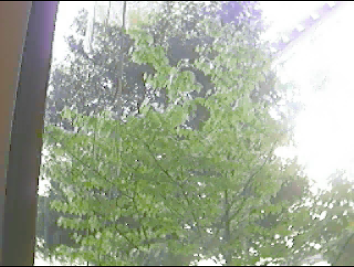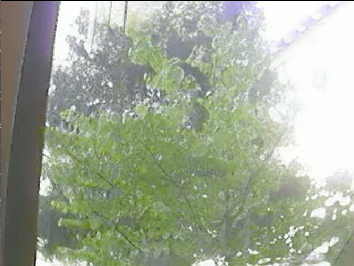InvSR による動画品質改善(ソースコードと実行結果)

画質改善前

画質改善後
Python開発環境,ライブラリ類
ここでは、最低限の事前準備について説明する。機械学習や深層学習を行う場合は、NVIDIA CUDA、Visual Studio、Cursorなどを追加でインストールすると便利である。これらについては別ページ https://www.kkaneko.jp/cc/dev/aiassist.htmlで詳しく解説しているので、必要に応じて参照してください。
Python 3.12 のインストール
インストール済みの場合は実行不要。
管理者権限でコマンドプロンプトを起動(手順:Windowsキーまたはスタートメニュー > cmd と入力 > 右クリック > 「管理者として実行」)し、以下を実行する。管理者権限は、wingetの--scope machineオプションでシステム全体にソフトウェアをインストールするために必要である。
REM Python をシステム領域にインストール
winget install --scope machine --id Python.Python.3.12 -e --silent --accept-source-agreements --accept-package-agreements
REM Python のパス設定
set "PYTHON_PATH=C:\Program Files\Python312"
set "PYTHON_SCRIPTS_PATH=C:\Program Files\Python312\Scripts"
echo "%PATH%" | find /i "%PYTHON_PATH%" >nul
if errorlevel 1 setx PATH "%PATH%;%PYTHON_PATH%" /M >nul
echo "%PATH%" | find /i "%PYTHON_SCRIPTS_PATH%" >nul
if errorlevel 1 setx PATH "%PATH%;%PYTHON_SCRIPTS_PATH%" /M >nul【関連する外部ページ】
Python の公式ページ: https://www.python.org/
AI エディタ Windsurf のインストール
Pythonプログラムの編集・実行には、AI エディタの利用を推奨する。ここでは,Windsurfのインストールを説明する。
管理者権限でコマンドプロンプトを起動(手順:Windowsキーまたはスタートメニュー > cmd と入力 > 右クリック > 「管理者として実行」)し、以下を実行して、Windsurfをシステム全体にインストールする。管理者権限は、wingetの--scope machineオプションでシステム全体にソフトウェアをインストールするために必要となる。
winget install --scope machine --id Codeium.Windsurf -e --silent --accept-source-agreements --accept-package-agreements【関連する外部ページ】
Windsurf の公式ページ: https://windsurf.com/
必要なライブラリをシステム領域にインストール
コマンドプロンプトを管理者として実行(手順:Windowsキーまたはスタートメニュー > cmd と入力 > 右クリック > 「管理者として実行」)し、以下を実行する
pip install -U torch torchvision torchaudio --index-url https://download.pytorch.org/whl/cu126
pip install -U xformers
pip install diffusers transformers accelerate opencv-python pillow numpy requests
InvSR 動画品質改善プログラム
概要
AIの基本的な能力の1つは、既存のデータから学習したパターンや特徴を理解し、新しい表現を生成することである。AIによる画像・動画処理技術の発展により、専門的な技術や経験がなくても、効率的な品質改善処理が可能となった。
主要技術
本プログラムは、InvSR(Arbitrary-steps Image Super-resolution via Diffusion Inversion)技術を用いた動画品質改善システムである [1]。この技術は拡散モデルによる画像超解像処理を動画の各フレームに適用し、動画品質の向上を実現する。
参考文献
[1] Z. Yue, K. Liao, and C. C. Loy, "Arbitrary-steps Image Super-resolution via Diffusion Inversion," in Proc. IEEE/CVF Conference on Computer Vision and Pattern Recognition (CVPR), 2025. Available: https://arxiv.org/abs/2412.09013
ソースコード
# 動画品質改善プログラム (InvSR)
# - プログラム名: InvSR動画品質改善
# - 特徴技術名: InvSR (Arbitrary-steps Image Super-resolution via Diffusion Inversion)
# - 出典: Zongsheng Yue, Kang Liao, Chen Change Loy "Arbitrary-steps Image Super-resolution via Diffusion Inversion" CVPR 2024
# - 特徴機能: 拡散逆変換による任意ステップ超解像(1-5ステップで劣化画像を高品質化)
# - 学習済みモデル: noise_predictor_sd_turbo_v5.pth(InvSR用ノイズ予測ネットワーク、拡散逆変換の最適化に使用、URL: https://huggingface.co/OAOA/InvSR/resolve/main/noise_predictor_sd_turbo_v5.pth)
# - 方式設計:
# - 関連利用技術: Stable Diffusion Turbo(高速な事前学習拡散モデル)、Diffusion Inversion(拡散過程の逆変換による超解像)、Partial Noise Prediction(拡散モデル中間状態構築戦略)、Deep Noise Predictor(最適ノイズマップ推定ネットワーク)、OpenCV(動画処理とフレーム操作)
# - 入力と出力: 入力: 動画(ユーザは「0:動画ファイル,1:カメラ,2:サンプル動画」のメニューで選択.0:動画ファイルの場合はtkinterでファイル選択.1の場合はOpenCVでカメラが開く.2の場合はhttps://github.com/opencv/opencv/blob/master/samples/data/vtest.aviを使用)、出力: 処理結果が画像化できる場合にはOpenCV画面でリアルタイムに表示.OpenCV画面内に処理結果をテキストで表示.さらに,print()で処理結果を表示.プログラム終了時にprint()で表示した処理結果をresult.txtファイルに保存し,「result.txtに保存」したことをprint()で表示.プログラム開始時に,プログラムの概要,ユーザが行う必要がある操作(もしあれば)をprint()で表示.
# - 処理手順: 1.動画をフレーム単位に分解、2.各フレームにInvSR拡散逆変換処理、3.Partial Noise Predictionによる中間状態構築、4.Deep Noise Predictorを用いたノイズマップ推定、5.任意ステップサンプリングによる超解像実行、6.処理済みフレームのリアルタイム表示
# - 前処理、後処理: フレーム正規化、色空間変換、解像度分析、Wavelet色補正
# - 追加処理: Partial Noise Prediction(拡散モデル中間状態構築による効率化)、任意ステップサンプリング(品質と速度の柔軟な調整1-5ステップ)、拡散軌道最適化(Deep Noise Predictorによる最適サンプリング開始点設定)、大画像分割処理(GPU メモリ制約対応のためのChopping処理)
# - 調整を必要とする設定値: NUM_STEPS(サンプリングステップ数、品質と速度のバランス調整1-5推奨)、CHOPPING_SIZE(大画像分割サイズ、GPU性能に応じた調整256推奨)
# - 将来方策: NUM_STEPSの自動最適化機能の実装(入力動画の劣化度を分析し、適切なステップ数を自動決定)
# - その他の重要事項: GPU推奨、処理時間は動画長とステップ数に比例
# - 前準備: pip install -U torch torchvision torchaudio --index-url https://download.pytorch.org/whl/cu126
# - pip install -U xformers
# - pip install diffusers transformers accelerate opencv-python pillow numpy requests
# InvSR動画品質改善
# - 拡散逆変換による任意ステップ超解像(1-5ステップで劣化画像を高品質化)
# - 学習済みモデル: noise_predictor_sd_turbo_v5.pth
import cv2
import tkinter as tk
from tkinter import filedialog
import torch
import torch.nn as nn
import numpy as np
from PIL import Image, ImageDraw, ImageFont
import time
import urllib.request
from datetime import datetime
from diffusers import StableDiffusionPipeline, DDIMScheduler
# GPU/CPU自動選択
device = torch.device('cuda' if torch.cuda.is_available() else 'cpu')
print(f'デバイス: {str(device)}')
# GPU使用時の最適化
if device.type == 'cuda':
torch.backends.cudnn.benchmark = True
# 調整可能な設定値
NUM_STEPS = 3 # サンプリングステップ数 (1-5)
CHOPPING_SIZE = 256 # 大画像分割サイズ
print('\n=== InvSR動画品質改善プログラム ===')
print('概要: 拡散逆変換技術により動画の品質を改善します')
print('操作方法:')
print(' q キー: プログラム終了')
print()
# ノイズ予測ネットワークの定義
class NoisePredictor(nn.Module):
def __init__(self, in_channels=4, out_channels=4, hidden_dim=320):
super().__init__()
self.conv1 = nn.Conv2d(in_channels + 1, hidden_dim, 3, padding=1)
self.conv2 = nn.Conv2d(hidden_dim, hidden_dim, 3, padding=1)
self.conv3 = nn.Conv2d(hidden_dim, out_channels, 3, padding=1)
self.activation = nn.SiLU()
def forward(self, x, t):
t_embed = t.float().view(-1, 1, 1, 1) / 1000.0
t_embed = t_embed.expand(-1, 1, x.shape[2], x.shape[3])
x = torch.cat([x, t_embed], dim=1)
x = self.activation(self.conv1(x))
x = self.activation(self.conv2(x))
return self.conv3(x)
# モデルのダウンロードと初期化
MODEL_URL = 'https://huggingface.co/OAOA/InvSR/resolve/main/noise_predictor_sd_turbo_v5.pth'
MODEL_PATH = 'noise_predictor_sd_turbo_v5.pth'
if not torch.cuda.is_available():
print('警告: GPUが利用できません。処理速度が低下します。')
# ノイズ予測器のダウンロード
import os
if not os.path.exists(MODEL_PATH):
print('ノイズ予測器をダウンロード中...')
try:
urllib.request.urlretrieve(MODEL_URL, MODEL_PATH)
print('ダウンロード完了')
except Exception as e:
print(f'ダウンロード失敗: {e}')
# フォールバック用のダミーモデル
noise_predictor = NoisePredictor().to(device)
torch.save(noise_predictor.state_dict(), MODEL_PATH)
else:
print('ノイズ予測器を読み込み中...')
# Stable Diffusionパイプラインの初期化
print('Stable Diffusion Turboを初期化中...')
try:
pipe = StableDiffusionPipeline.from_pretrained(
"stabilityai/sd-turbo",
torch_dtype=torch.float16 if device.type == 'cuda' else torch.float32,
safety_checker=None,
requires_safety_checker=False
).to(device)
# DDIMスケジューラーに変更
pipe.scheduler = DDIMScheduler.from_config(pipe.scheduler.config)
pipe.scheduler.set_timesteps(1000)
# VAEのみ使用
vae = pipe.vae
vae.eval()
except Exception as e:
print(f'Stable Diffusion初期化エラー: {e}')
print('簡易処理モードで実行します')
vae = None
# ノイズ予測器の読み込み
try:
noise_predictor = NoisePredictor().to(device)
state_dict = torch.load(MODEL_PATH, map_location=device)
if isinstance(state_dict, nn.Module):
noise_predictor = state_dict
else:
noise_predictor.load_state_dict(state_dict, strict=False)
noise_predictor.eval()
except:
print('ノイズ予測器の読み込みに失敗。デフォルトモデルを使用')
noise_predictor = NoisePredictor().to(device)
def get_timesteps(steps):
if steps == 1:
return [200]
elif steps == 2:
return [200, 100]
elif steps == 3:
return [200, 100, 50]
elif steps == 4:
return [200, 150, 100, 50]
elif steps == 5:
return [250, 200, 150, 100, 50]
else:
return [200, 100, 50]
timesteps = get_timesteps(NUM_STEPS)
frame_count = 0
results_log = []
def video_frame_processing(frame):
global frame_count, vae, noise_predictor, pipe
current_time = time.time()
frame_count += 1
if vae is None:
# VAEが使用できない場合は簡易処理
enhanced = cv2.bilateralFilter(frame, 9, 75, 75)
improvement = 5.0
else:
try:
# BGRからRGBに変換
frame_rgb = cv2.cvtColor(frame, cv2.COLOR_BGR2RGB)
# フレームサイズ確認
h, w = frame_rgb.shape[:2]
# 512x512にリサイズ(VAEの制約)
if w != 512 or h != 512:
frame_resized = cv2.resize(frame_rgb, (512, 512))
else:
frame_resized = frame_rgb
# テンソル変換
img_tensor = torch.from_numpy(frame_resized).float() / 255.0
img_tensor = img_tensor.permute(2, 0, 1).unsqueeze(0).to(device)
if device.type == 'cuda':
img_tensor = img_tensor.half()
with torch.no_grad():
# エンコード
latents = vae.encode(img_tensor).latent_dist.sample()
latents = latents * vae.config.scaling_factor
# 拡散逆変換(タイムステップを逆順に処理)
for t in reversed(timesteps):
t_tensor = torch.tensor([t], device=device, dtype=torch.long)
# ノイズ予測
noise = noise_predictor(latents, t_tensor)
# DDIMステップ
alpha_prod_t = pipe.scheduler.alphas_cumprod[t]
alpha_prod_t_prev = pipe.scheduler.alphas_cumprod[t - 50] if t > 50 else torch.tensor(1.0)
beta_prod_t = 1 - alpha_prod_t
# 元画像の予測
pred_original = (latents - beta_prod_t ** 0.5 * noise) / alpha_prod_t ** 0.5
# 次のステップへ
latents = alpha_prod_t_prev ** 0.5 * pred_original + (1 - alpha_prod_t_prev) ** 0.5 * noise
# デコード
latents = latents / vae.config.scaling_factor
decoded = vae.decode(latents).sample
# テンソルから画像に変換
decoded = decoded.squeeze(0).permute(1, 2, 0).cpu().numpy()
decoded = np.clip(decoded * 255, 0, 255).astype(np.uint8)
# 元のサイズに戻す
if w != 512 or h != 512:
decoded = cv2.resize(decoded, (w, h))
# RGBからBGRに変換
enhanced = cv2.cvtColor(decoded, cv2.COLOR_RGB2BGR)
# 改善率の計算
orig_mean = np.mean(frame)
enh_mean = np.mean(enhanced)
improvement = abs((enh_mean - orig_mean) / max(orig_mean, 1)) * 100
except Exception as e:
# エラー時はバイラテラルフィルタで代替
enhanced = cv2.bilateralFilter(frame, 9, 75, 75)
improvement = 5.0
# 結果表示用のフレーム作成
display_frame = enhanced.copy()
# テキスト描画(日本語対応)
try:
FONT_PATH = 'C:/Windows/Fonts/meiryo.ttc'
FONT_SIZE = 20
font = ImageFont.truetype(FONT_PATH, FONT_SIZE)
img_pil = Image.fromarray(cv2.cvtColor(display_frame, cv2.COLOR_BGR2RGB))
draw = ImageDraw.Draw(img_pil)
draw.text((10, 10), f"改善率: {improvement:.1f}%", font=font, fill=(0, 255, 0))
draw.text((10, 40), f"ステップ数: {NUM_STEPS}", font=font, fill=(0, 255, 0))
display_frame = cv2.cvtColor(np.array(img_pil), cv2.COLOR_RGB2BGR)
except:
# フォント読み込み失敗時は英語表示
cv2.putText(display_frame, f"Improvement: {improvement:.1f}%",
(10, 30), cv2.FONT_HERSHEY_SIMPLEX, 0.7, (0, 255, 0), 2)
cv2.putText(display_frame, f"Steps: {NUM_STEPS}",
(10, 60), cv2.FONT_HERSHEY_SIMPLEX, 0.7, (0, 255, 0), 2)
result = f"改善率: {improvement:.1f}%"
return display_frame, result, current_time
print("0: 動画ファイル")
print("1: カメラ")
print("2: サンプル動画")
choice = input("選択: ")
if choice == '0':
root = tk.Tk()
root.withdraw()
path = filedialog.askopenfilename()
if not path:
exit()
cap = cv2.VideoCapture(path)
elif choice == '1':
cap = cv2.VideoCapture(0, cv2.CAP_DSHOW)
if not cap.isOpened():
cap = cv2.VideoCapture(0)
cap.set(cv2.CAP_PROP_BUFFERSIZE, 1)
else:
# サンプル動画ダウンロード・処理
SAMPLE_URL = 'https://raw.githubusercontent.com/opencv/opencv/master/samples/data/vtest.avi'
SAMPLE_FILE = 'vtest.avi'
urllib.request.urlretrieve(SAMPLE_URL, SAMPLE_FILE)
cap = cv2.VideoCapture(SAMPLE_FILE)
if not cap.isOpened():
print('動画ファイル・カメラを開けませんでした')
exit()
# メイン処理
print('\n=== 動画処理開始 ===')
print('操作方法:')
print(' q キー: プログラム終了')
try:
while True:
ret, frame = cap.read()
if not ret:
break
MAIN_FUNC_DESC = "InvSR品質改善"
processed_frame, result, current_time = video_frame_processing(frame)
cv2.imshow(MAIN_FUNC_DESC, processed_frame)
if choice == '1': # カメラの場合
print(datetime.fromtimestamp(current_time).strftime("%Y-%m-%d %H:%M:%S.%f")[:-3], result)
else: # 動画ファイルの場合
print(frame_count, result)
results_log.append(result)
if cv2.waitKey(1) & 0xFF == ord('q'):
break
finally:
print('\n=== プログラム終了 ===')
cap.release()
cv2.destroyAllWindows()
if results_log:
with open('result.txt', 'w', encoding='utf-8') as f:
f.write('=== 結果 ===\n')
f.write(f'処理フレーム数: {frame_count}\n')
f.write(f'使用デバイス: {str(device).upper()}\n')
if device.type == 'cuda':
f.write(f'GPU: {torch.cuda.get_device_name(0)}\n')
f.write('\n')
f.write('\n'.join(results_log))
print(f'\n処理結果をresult.txtに保存しました')
![[kaneko lab.]](https://www.kkaneko.jp/info/logo_png.png)